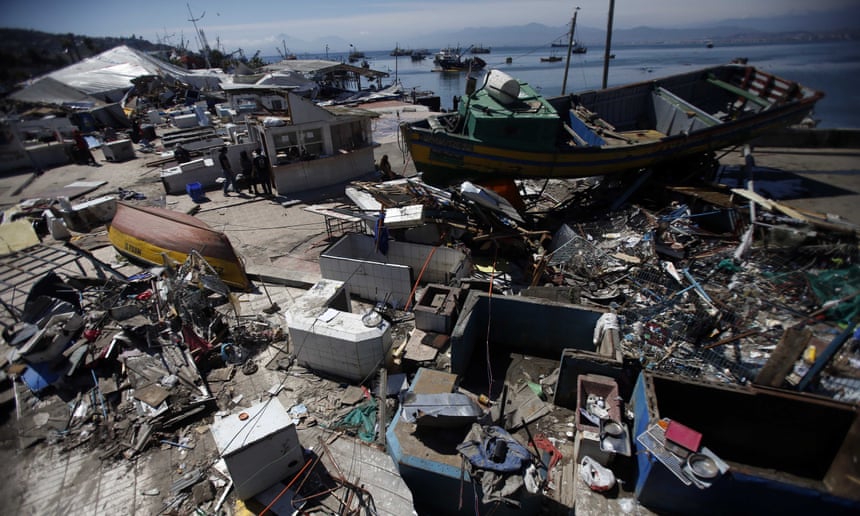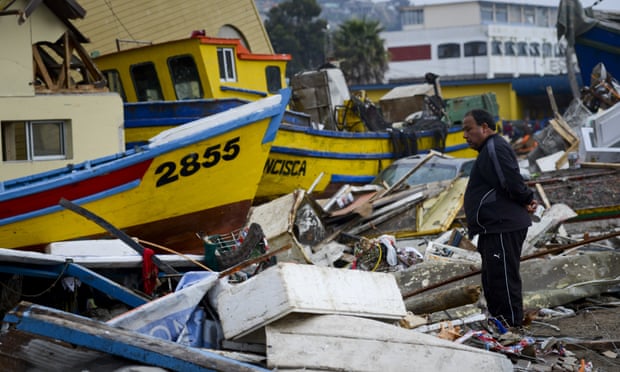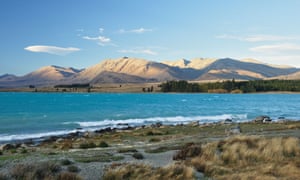How did Chile manage to survive its recent earthquake virtually unscathed?
Chile has one of the most effective disaster relief infrastructures in the world – led by a general who lost his wife in the 2010 quake in Haiti. How? It’s all down to rigorous building codes, evacuation simulations and, above all, preparation
When the Chilean city of Coquimbo was hit by a 4.5-metre tsunami wave on 16 September, the surge of water crushed a neighbourhood of small, independent fishing outfits. Nearly 200 boats were destroyed: some dragged out to sea, others piled onshore like driftwood or dumped inland, many blocks from the ocean.
A river of water pushed debris and sand throughout a bustling section of the town’s waterfront just as darkness was settling on the 150,000-person city. Nine people were killed in the Coquimbo region, and a further four elsewhere in Chile.
So why did only 13 die in an quake measuring 8.4 on the Richter scale – the world’s strongest earthquake to date this year – while far weaker earthquakes in Haiti and, more recently, Nepal, killed tens of thousands?
Part of the answer lies inside a field hospital tent in Santiago, Chile’s capital and largest city where, on Wednesday 24 September, huddled around plastic tables and squished against the walls of a military tent lit by fluorescent tubes, search and rescue teams from Peru, El Salvador, the United States and Spain take part in a previously scheduled rescue simulation known as Simex 2015. Sipping tepid coffee, they debate where to search with dogs, which collapsed building might possibly contain dead bodies and how best to rescue tsunami victims along the coast.
Organised by the UN humanitarian affairs office and the International Search and Rescue Advisory Group [Insarag], the Simex meetings were launched in the wake of huge quakes in Armenia and Mexico. Today Insarag is a leading authority on best practices to organise urban search and rescue operations following earthquakes. The weeklong meeting in Santiago includes a full-scale emergency reaction to a simulated 9.0 earthquake hit with an epicentre in Santiago.
“This is an exercise,” says Ricardo Toro, a former army general now in charge of Chile’s disaster relief agency, ONEMI. “We have a plan called ‘Chile Prepares’ of which the principal and most important part is evacuation exercises. Every year we – at a minimum – run six or seven evacuations of entire regions.”
Describing the evacuations during the initial hours after last Wednesday’s quake, Toro says: “A million people were evacuated and that saved a lot of lives. Had we not had such an evacuation, there would have been many, many more deaths.”
Toro knows first-hand the deadly nature of giant earthquakes. Under the command of the UN, he was stationed in Port au Prince in 2010 when the 7.7-magnitude earthquake destroyed the city. Thousands of poorly designed buildings, with little or no reinforced concrete, completely collapsed. Medical facilities and search and rescue teams were overwhelmed. Within a week, the death toll from the Haitian quake was estimated at more than 200,000 – including Maria Teresa Dowling, Toro’s wife.
“I lost my wife and that gives me quite a bit of empathy with the people who suffer losses,” he says. “That is why these prevention systems have to focus on saving lives.
“I think Haiti was the beginning. The rescue teams that arrived were not coordinated. They worried more about where the press was in order to get attention. Now it is a professional procedure, with protocols. In a disaster, improvisation is the worst.”
“Five years ago, we never could have imagined having an exercise like this in Chile,” says Christophe Schmachtel, a UN humanitarian affairs officer based in Geneva. “In 2010 [when Chile suffered another devastating earthquake], I had no focal points here. We didn’t know who to call.
“Our way to inform the international community was to watch TV and then report to UN Agencies … It took us two or three days to get through and get official, direct information. The government of Chile did not have much information on how the international community was organised and worked. That has changed.”
In the most recent earthquake, a new system of warnings was used to alert the population. Within minutes of the quake, downtown Coquimbo and its coastal areas were rocked by loud sirens. A convoy of ambulances, firefighters and police sought to accelerate the evacuation, as officers convinced reluctant homeowners to head for the hills. Mobile phones were targeted with a series of tsunami warning messages, urging residents to abandon the coastal areas.
“During this latest quake, I was on the phone with the [Chilean] government within 30 minutes – and then informing the international community that the government was under control and there was no need for international assistance,” Schmachtel says. “The difference between being in a earthquake and being in a disaster is the level of preparation – and this begins with Chile’s strict building codes.”
The country’s building codes require that all new buildings must be able to survive a 9.0-magnitude earthquake. The building can crack, tilt and even be declared unfit for future use – but it must not collapse. Discussing the 2010 earthquake, Felipe Espinoza, a Chilean firefighter, counts – on one hand – the multi-storey buildings destroyed. “The earthquake was 8.8 and there were 6,000 buildings in the affected area – yet only six were seriously damaged, and of those, only four had to be demolished.”
Walter Fonseca, chief of operations for Costa Rica’s National Emergency Commission, says the crucial factor that kept the death toll so low this time around is not the building codes themselves, but their steady enforcement throughout Chile. No multi-storey buildings are thought to have collapsed in the most recent earthquake. “This shows the capacity and thoroughness of local [Chilean] municipal governments,” says Fonseca. “Those are the ones who are actually inspecting and approving the design and construction of buildings.”
Schmachtel says Chile’s earthquake response protocols went through a complete upgrade following the government’s chaotic response to the 8.8-magnitude earthquake of February 2010. More than 500 people were killed, and fault lines in the government’s communications network were exposed as different regions had no way to communicate with officials in Santiago.
Furthermore, the government’s refusal to issue a tsunami warning led to dozens of beachgoers being swept away by a series of massive tsunami waves. Four government officials were later charged with involuntary manslaughter.
But there is another factor that has helped Chile to cope with powerful earthquakes – namely, the regularity of small-to-medium size quakes which do little damage, but serve to remind the public of the looming danger. So many earthquakes strike Chile that a popular national drink is called the Terremoto (earthquake), made from white wine, fernet, grenadine and pineapple ice cream, and a followup is known as the replica (aftershock).
As part of the “Ring of Fire” stretching all the way to Alaska and Japan, Chile is constantly being shaken. But it was also the site of the largest earthquake ever recorded – in the small, southern city of Valdivia in 1960. That 9.5-magnitude quake left an estimated 5,000 dead, and kindled a deep cultural appreciation for strict building codes.
“Chile today has completely learned UN protocols and adapted them to local needs,” Schmachtel says. “Chile has become a showcase. In our global meetings [on earthquake preparation], Chile is now the example.”








No comments:
Post a Comment
Please leave a comment-- or suggestions, particularly of topics and places you'd like to see covered